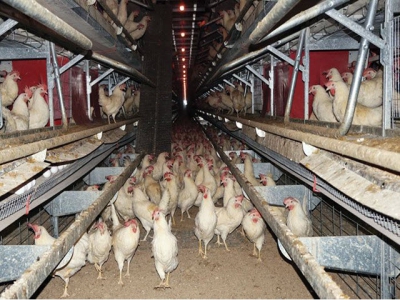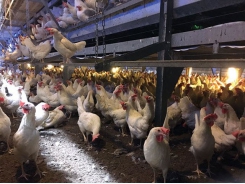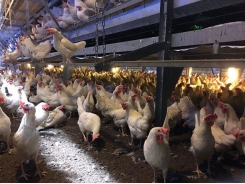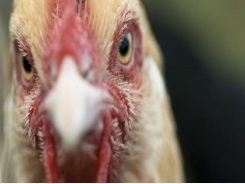Cage-free housing increases layer gut health challenges

In cage-free systems, the hens have access to manure from flock mates, which increases the likelihood of gut parasites like coccidia and worms being spread throughout the barn. | Austin Alonzo
Setting up a program for diagnosing gut health challenges in layers and pullets is of increasing importance as more flocks are housed cage free.
Gut health in layers may be more important than ever. “To some extent, gut health has not been a focus of commercial pullet and layer flocks unless the problem contributed to a significant mortality problem for a company or facility,” said Dan Wilson, DVM with Wilson Veterinary Company, at the 2018 Midwest Poultry Federation Convention.
Gut health hasn’t been a major issue because various kinds of cage-housing systems have kept birds from fecal-oral exposure from hatch to depopulation.
“As live production operations move to newer styles of alternative housing of pullets and layers we will likely see increased gut health challenges in these flocks due primarily to the increased access to fecal matter,” said Wilson. “Breeder companies continue to make progress in flock efficiency and productivity, and producers may find that maintaining gut health will be a critical component to exercising these birds’ genetic potential.”
Professionals within the layer industry may have to learn investigation and intervention practices for gut health in ways that have never been explored before. “As our counterparts in the broiler and turkey industries already know, both subclinical and clinical gut health challenges can impact the health, welfare and profitability of flocks,” he said.
While some may see investigation strategies, testing and gut health prevention tactics as added cost, Wilson explained that they should be viewed as a potential return on investment opportunity to improve flock performance.
Gut health investigation tools
When looking at gut health, evaluate the collection methodology and accuracy of egg production, body weight, case weight, feed consumption, feed conversion and water consumption. If there is a sudden drop in any of these factors, gut health may be to blame.
Manure evaluation
Manure evaluation seems basic to some but is a crucial part of managing gut health. “Manure quality from flocks should be continuously evaluated by farm and production staff,” Wilson said. Depending on the housing system type, manure should be evaluated from deep pit areas, scraper boards, manure belts and litter areas or outdoor access areas.
“In the event a farm would like to look at fresh fecal matter it works best to place cardboard or other flat collection material underneath affected flocks just prior to a feeding time and leave these beneath the flock for 30 to 45 minutes to collect the fresh fecal matter,” he said. This method also allows the user to evaluate the moisture content and texture better than inspecting the manure collection areas in the house.

Cage-free hens can exhibit natural behaviors like dust bathing in litter, but this can also increase exposure to dust containing fecal bacteria. | Photo by Big Dutchman
Manure can be difficult to examine in poor lighting. “A flashlight is critical,” Wilson said.
Production staff are encouraged to use a flashlight to look for changes in manure conditions. Many problems can be overlooked due to poor lighting or farm staff not taking time to note manure conditions.
“You don’t want to wait to hear about manure condition changes from environmental crews; you’ve waited too long at that point,” he said.
In addition to the moisture content of the manure, it should also be checked for undigested feed particles, intestinal sloughing (orange/red material present in manure), watery droppings and abnormal coloring and textures (foamy, pasty, butterscotch colored, etc.).
Bird handling
Randomly selected birds should be handled and inspected by flock management personnel, nutrition staff and veterinarians to evaluate for external indicators of a gut health challenge. When professionals are handling the birds, they should assess the birds’ muscle, fat and skeleton composition in comparison to flock age and look for dirty, wet and matted feathers around the vent.
“Whoever takes weekly body weights could also handle taking these notes about the birds,” Wilson said.
Mortality
In the instance of mortality, producers should look for gross lesions of enteritis, necrotic enteritis and evaluate body composition.
“Mortality should be evaluated by a person trained in necropsy,” Wilson said. Necropsy of mortality, even if mortality is not elevated relative to breed standards, can still be helpful to identify potential gut health challenges, he explained.
However, sacrifice birds or birds culled with other clinical signs offer a better opportunity to evaluate gut health. “After death, the GI [gastrointestinal] tract degrades very quickly, and post-mortem changes can be confused with a gastrointestinal problem,” Wilson explained, such as ballooning gastrointestinal tracts and watery contents.
Sacrifice bird evaluation
Sacrifice birds or selected cull birds can be beneficial in gut health investigation. A minimum of five randomly selected birds are euthanized and evaluated by a professional.
“The GI tract should be opened from the crop to the distal end of the tract to inspect the quality of the GI lining in each section of the tract and to note any obvious gross lesions,” Wilson explained.
Abnormalities worth noting on a gut health investigation are unusual crop and gizzard contents, thin-walled gastrointestinal tract, watery mucus-coated gastrointestinal digesta, watery to foamy contents, presence of orange to red mucus in the tract, undigested feed particles in the distal gastrointestinal tract near the cloaca and visual identification of internal parasites (tapeworms, roundworms, etc.).
Diagnostic methods
Diagnostic methods for gut health investigations may include Coccidiosis oocyst counts, internal parasite egg counts, gastrointestinal scrapings, gut histopathology surveys, gut flora enumeration, viral gastrointestinal diagnostics and ancillary aspects of gut health investigation (nutritional changes, feed and ingredient quality and water quality).
These diagnostic methods all have their own processes that can be rather complicated. Some of them are newer methods that can be costly.
Intervention methods for gut health
“You are only going to get out of the bird what you put into it, so you have to focus on basics,” Wilson said. This is important when managing bird gut health.
When flocks are found to be in a state of dysbacteriosis, products like prebiotics, probiotics, essential oils and phytogenic products can be of value in restoring the proper gastrointestinal flora and trending farms and flocks back to a more normal flora.
When gastrointestinal tract pH is maintained under more optimal conditions (<7 pH), the normal gut flora is more likely to be maintained, the gut is more likely to be efficient and less prone to gastrointestinal challenges. “Drinking water acidification can be helpful in helping the bird maintain a proper gut pH and flora,” Wilson said.
Locational housing system management practices are obviously important too when maintaining bird gut health. Facility maintenance, litter and range management, house downtime and sanitation, whole-house fumigation and whole-house heating should all be implemented, he explained.
Wilson did see success in whole-house heating in certain circumstances, but after a year of using the method, it became ineffective.
Commercial layers are fairly limited in available treatment options, with regards to antibiotic usage. “Care must be taken when using any antibiotic protocol to make sure the use of the product does not affect the marketing of the egg products or create any negative effects on gut flora for the flock,” Wilson said.
Professionals are now looking at doing autogenous vaccination. “If viral causes of enteritis are routinely found that correlate with production challenges, an autogenous vaccine can be created. This autogenous vaccine can be produced from virus isolations taken from clinical case submissions,” said Wilson. However, this process can be expensive and has limitations due to autogenous vaccine regulations.
“Gut health investigation can be costly, but worth it. It is a very slow process to figure problems out and they are often multifactorial,” Wilson concluded.
Related news
Tools

Phối trộn thức ăn chăn nuôi

Pha dung dịch thủy canh

Định mức cho tôm ăn

Phối trộn phân bón NPK

Xác định tỷ lệ tôm sống

Chuyển đổi đơn vị phân bón

Xác định công suất sục khí

Chuyển đổi đơn vị tôm

Tính diện tích nhà kính

Tính thể tích ao




 4 ways to maximize poultry processing yields
4 ways to maximize poultry processing yields  New stress response component identified in poultry brain
New stress response component identified in poultry brain